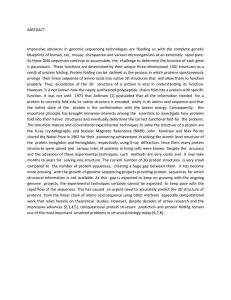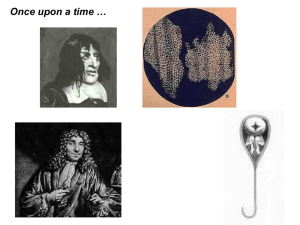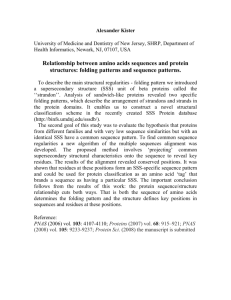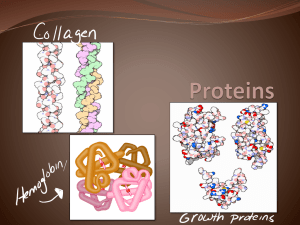PROTEINS
advertisement
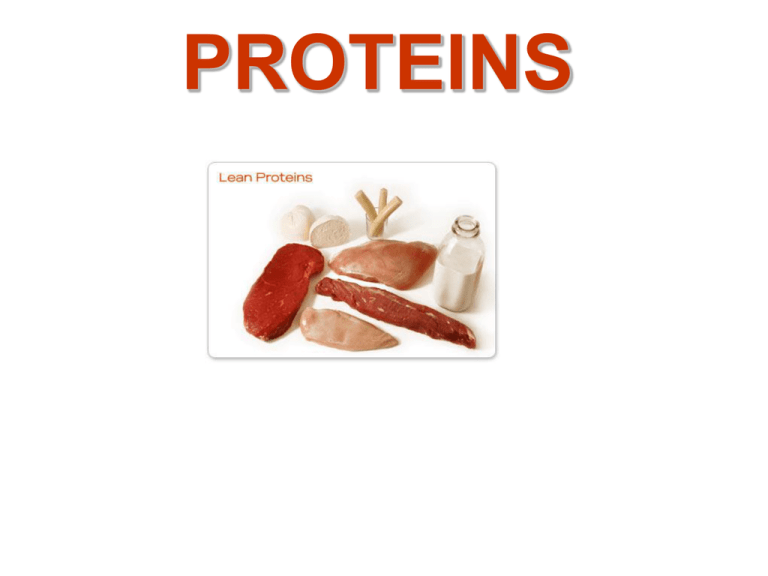
PROTEINS PROTEINS Traditional Architecture Form fits function Wood, brick, nails, glass Materials Temperature, earthquakes Environmental Factors How many people? Population Factors Molecular Architecture Amino acids, cofactors Temperature, solubility # partner proteins, # reactants How many doors and windows? Portals Spanish, Victorian, Motifs/Styles Conserved domains or protein folds Architect Evolution Passages for substrates 1950's blocky science building Julia Morgan and reactants Levels of Protein Structure Primary structure = order of amino acids in the protein chain Charged and polar R-groups tend to map to protein surfaces Non-polar R-groups tend to be buried in the cores of proteins Myoglobin Blue = non-polar R-group Red = Heme Amino Acids Are Joined By Peptide Bonds In Peptides - a-carboxyl of one amino acid is joined to a-amino of a second amino acid (with removal of water) - only a-carboxyl and a-amino groups are used, not R-group carboxyl or amino groups Chemistry of peptide bond formation The peptide bond is planar This resonance restricts the number of conformations in proteins -- main chain rotations are restricted to f and y. Primary sequence reveals important clues about a protein • Evolution conserves amino acids that are important to protein structure and function across species. Sequence comparison of multiple “homologs” of a particular protein reveals highly conserved regions that are important for function. • Clusters of conserved residues are called “motifs” -- motifs carry out a particular function or form a particular structure that is important for the conserved protein. motif DnaG E. coli small hydrophobic DnaG S. typ large hydrophobic DnaG B. subt polar gp4 T3 positive charge gp4 negative T7 charge ...EPNRLLVVEGYMDVVAL... ...EPQRLLVVEGYMDVVAL... ...KQERAVLFEGFADVYTA... ...GGKKIVVTEGEIDMLTV... ...GGKKIVVTEGEIDALTV... : : : : * * * : : Secondary structure = local folding of residues into regular patterns The a-helix • In the a-helix, the carbonyl oxygen of residue “i” forms a hydrogen bond with the amide of residue “i+4”. • Although each hydrogen bond is relatively weak in isolation, the sum of the hydrogen bonds in a helix makes it quite stable. • The propensity of a peptide for forming an a-helix also depends on its sequence. The b-sheet • In a b-sheet, carbonyl oxygens and amides form hydrogen bonds. • These secondary structures can be either antiparallel (as shown) or parallel and need not be planar (as shown) but can be twisted. • The propensity of a peptide for forming b-sheet also depends on its sequence. Why do Secondary Structures form Tertiary structure = global folding of a protein chain Tertiary structures are quite varied Quaternary structure = Higher-order assembly of proteins Examples of other quaternary structures Tetramer SSB Allows coordinated DNA binding Hexamer Filament DNA helicase Recombinase Allows coordinated DNA binding Allows complete and ATP hydrolysis coverage of an extended molecule Quaternary Structures Classes of proteins Functional definition: Enzymes: Accelerate biochemical reactions Structural: Form biological structures Transport: Carry biochemically important substances Defense: Protect the body from foreign invaders Structural definition: Globular: Complex folds, irregularly shaped tertiary structures Fibrous: Extended, simple folds -- generally structural proteins Cellular localization definition: Membrane: In direct physical contact with a membrane; generally water insoluble. Soluble: Water soluble; can be anywhere in the cell. Protein Overview Need to understand physical principles underlie the passage from sequence to structure to dynamics QuickTime™ and a Sorenson Video 3 decompressor are needed to see this picture. Function LEVINTHAL PARADOX 100 a.a in general If there are 10 states/a.a 10100 conformations Three Folding Problems • Computational: Protein structure prediction from an amino acid sequence. • .Folding speed: “Levinthal paradox” the kinetic question how can a protein fold so fasts • The folding code: The ”thermodynamic” question of how a native structure results from interatomic forces acting on an amino acid sequence What if proteins misfold? • Diseases such as Alzheimer's disease, cystic fibrosis, BSE (Mad Cow disease), and even many cancers are believed to result from protein misfolding. • When proteins misfold, they can clump together ("aggregate"). These clumps can often gather in the brain, where they are believed to cause the symptoms of Mad Cow or Alzheimer's disease. Experimental Structure Prediction • Electron Microscopy: Structural information for large macromolecules at low resolution • NMR (Nuclear Magnetic Resonance) Spectroscopy: A solution of protein is placed in a magnetic field and the effects of different radio frequencies on the resonance of different atoms in proteins. • X-ray crystallography: The beam of x-rays are passed through a crystal of protein. Atoms in the protein crystal scatter the x-rays, which produce a diffraction pattern on a photographic film. Pros and Cons • None of them is high throughput technology • NMR – – – – Size of protein limited (about 200 residues) Protein must be soluble can provide the structure in near physiological condition can provide informations about dynamics • X-ray Crystallography – Must be able to crystallize protein – Accurate X-ray crystallography QuickTime™ and a TIFF (LZW) decompressor are needed to see this picture. NMR QuickTime™ and a TIFF (LZW) decompressor are needed to see this picture. Why Predict Protein Structures? High Resolution Structures better than 3Å To eliminate protein structure determination To speed up drug discovery From a computational point of view: ‘Protein folding problem’ Sequence --------------> Structure Dill & Chan Function A fundamental paradigm of protein science: The amino acid sequence encodes the structure; the structure determines the What is a molecular dynamics simulation? • Simulation that shows how the atoms in the system move with time • Typically on the nanosecond timescale • Atoms are treated like hard balls, and their motions are described by Newton’s laws. Molecular Dynamics Theory MD as a tool for minimization Energy Molecular dynamics uses thermal energy to explore the energy surface State A State B Energy minimization stops at local minima Folding Energy Landscape The Folding @ Home initiative (Vijay Pande, Stanford University) http://folding.stanford.edu/ The Folding @ Home initiative


